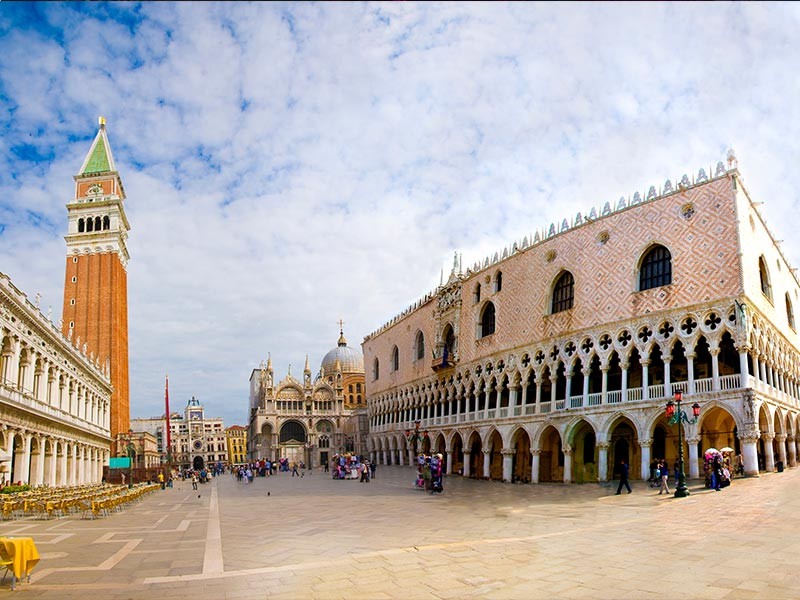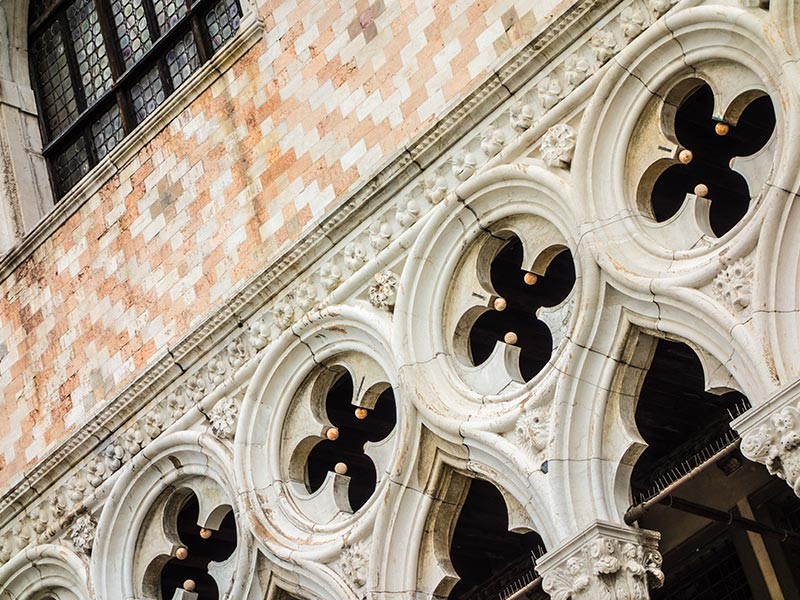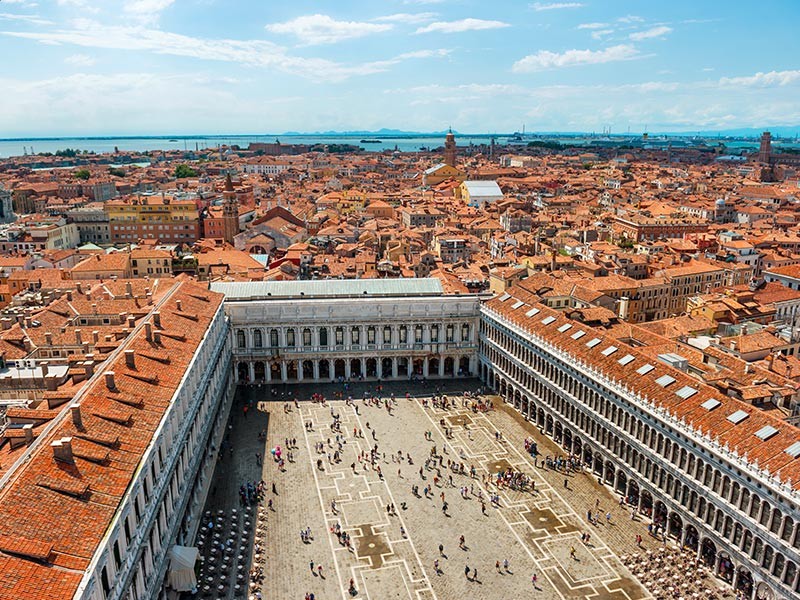A masterpiece of Gothic Architecture, the Doge’s Palace is an accumulation of layer upon layer of building work and ornamentation, comprising the original foundations, the fourteenth/fifteenth-century structure, sizeable Renaissance additions and opulent Mannerist details.
Info & Booking
Explore four museums in the heart of Venice, including its most visited attraction: the Doge's Palace, a masterpiece of Gothic art and the seat of the government of the splendid and powerful Republic of Venice.
This Combo Ticket includes the Doge's Palace, Museo Correr, Archaeological Museums and the Biblioteca Nazionale Marciana, all located on St. Mark's Square.
Ticket must be picked up at Doge's Palace
This reservation is made through an agency authorized by the official licensee of Venice Museums.
ATTENTION: By selecting "audioguide" visit will also include this service for Doge's Palace; audioguides are available in Italian, English, French, German and Spanish; duration 1 hour and 40 minutes.
Reservations must be made with a minimum of 1 day notice.
Save time in ordering! Add into your basket all the museum tickets you want, then fill the form and send the request.
Before making your reservation, please, read the Ordering Informations
IMPORTANT NOTICE: After succesfully completing a reservation, you will receive two e- mails: the copy of your order (immediately after submitting your order) and the confirmation mail (one working day after). In order to receive them, please make sure you insert your e-mail address correctly and check that your anti-spam filter or antivirus are not blocking mails from our address [email protected]. Special attention for AOL mailbox users.
PLEASE NOTICE: Confirmed time is not always the same time you requested; museum automatically confirms the closest available time on the same date if requested time is sold out.
Opening hours
- November 1 to March 31: 8:30am to 7pm
- April 1 to October 31: 8:30am to 9pm
Last access allowed 1 hour before closure.
Closed on December 25 and January 1.
Cancellation Policy:
For cancellations once a confirmation code has been assigned to the reservation, up to 2 days before the date of the visit, we can refund cost of unused tickets minus service fee (reservation fee and online booking fee). For further cancellations and no shows, no refund is possible.
Before You Book
PLEASE NOTE: Immediately after submitting an order, you will receive two email. The first email contains your order summary (this one you receive immediately after placing your order), the second email confirms your successful payment (one business day after placing the order). In order to receive these two emails, please make sure that you enter your email address correctly and check that antispam or antivirus filters do not block emails from our [email protected] address. Users of AOL, Comcast and Sbcglobal.net need to pay special attention to this, please. Vouchers will also be available, one business day after the request, at your dashboard.
IMPORTANT NOTE: The time you select on the order form is your preferred time. The closest available time, which can be anytime during opening hours on the selected date, will be automatically confirmed if your preferred time is no longer available.
Doge's Palace
The Palazzo Ducale (Doge's Palace) is a masterpiece of gothic art. And yet, a wide variety of architectural and ornamental elements contribute to its splendor, from ancient foundations built in the 1300s to the Renaissance additions including splendid manneristic details.
Your visit of the Doge's Palace begins by entering the palace complex through the Porta del Frumento intothe courtyard surrounded by the four wings. The small marble facade with the clock dates back to 1615. Two bronze wells from the middle of the 16th century are located in the center of the courtyard. The two oldest wings of the Doge's Palace present simple facades. The Renaissance wing shows rich decorations, including the Giant's Stairway, with the impressive statues of Mars and Neptune (sculpted by Sansovino in 1565), symbolizing the power of Venice on land and sea.
The staircase, conceived by Antonio Rizzo, is next to the arch built in the period of Doge Francesco Foscari. It is faced with Istria stone and red marble from Verona. The staircase leads to the Porta della Carta through the Foscari entrance hall, which is nowadays the visitors’ exit from the Doge's Palace. To the right of the stairway is the Cortile dei Senatori (16th century), where the senators would wait before government meetings. On the other side of this same wing the majestic Scala dei Censori (Censor's Staircase) leads to the upper floors of the Doge's Palace.
The Museo dell'Opera hosts ancient architectural pieces of the Doge's Palace, including the capitals that were substituted by copies in an important restoration effort in 1875. These precious sculptures decorated the medieval facades of the Doge's Palace with allegoric, religious, moral, and political statements.
The first floor, called Piano delle Logge, includes entrances to the east, south, and west wings. From here, you can enjoy splendid views of the courtyard and the Piazzetta San Marco. This floor hosts the offices of the Soprintendenza per i Beni Ambientali e Architettonici di Venezia and some offices of the direction of the Musei Civici Veneziani.
From here, your Doge's Palace visit proceeds to the Scala d'Oro (Golden Staircase) through the Renaissance wing. This wing hosted the offices of many magistrates. You will see some lions' mouths on the wall: citizens could place crime or embezzlement accusations into these. The messages would fall into a wooden box opened by the office to which they were addressed.
On this same wall you will also see two plaques. The first dates from the papacy of Urban V during the 1300s: It promises indulgences to whoever showed charity to prisoners. The other was created by Alessandro Vittoria to celebrate the 1674 visit of Henry III of France to Venice. Marble sculptures by Tiziano Aspetti decorate the access to the Scala d'Oro: one represents Atlas holding the heavens, the other Hercules killing the many-headed Hydra.
The apartments of the Doge are located in the palace area between the Rio della Canonica (the aquatic entrance to the Doge’s Palace), the Scala d'Oro and the apse of the Basilica di San Marco. A small but prestigious residence formed the basic nucleus of the apartments, while the rooms closest to the Scala d'Oro had the function of bridging the private life of the doge with his public duties. The doge retired to the private residence for dinner and to pass time with the members of his family at the end of the day.
Between the Piano delle Logge and the second floor lies the Atrio Quadrato (Square Atrium). This atrium leads to the Stanze Istituzionali (Institutional Rooms), where the political and administrative life of the Republic was conducted. The main branches of government worked here: the Maggior Consiglio (Great Council), the Senato (Senate), the Collegio (Cabinet), and the most important justice magistrates, from the Consiglio dei Dieci (Council of the Ten) to the Quarantie (Appeal Court). In all the rooms, the decorations celebrate the virtue of the State and its functions.
The Doge's Palace, seat of all government institutions of the Republic, included the justice department and the prisons. During the second half of the 1500s a new building was constructed on the other side of the river entirely dedicated to prison functions. The construction of these “New Prisons” had the purpose of improving the living conditions of the prisoners.
Following tradition, the walls, roof, and ceiling of each cell were coated with crossed larch wood layers. These New Prisons are one of the first examples of construction solely dedicated for use as a state prison.
Your itinerary then takes you to the two lower floors and the prison courtyard, where you will also see the ceramic collection found during the archaeological excavations in the area. Your visit then continues to the Ponte dei Sospiri and the Sala dei Censori.
The Ponte dei Sospiri (Bridge of Sighs) was created in 1614 to connect the Doge's Palace to the New Prisons building. Two corridors separated by a wall form this famous closed and covered bridge. One corridor links the prisons to the Sale del Magistrato alle Leggi, the Sala della Quarantia Criminal, and to the noble floor of the palace. The other corridor joins the prisons to the Sale dell'Avogaria and the Parlatorio. Both corridors are connected to the stairs that lead from the Pozzi (the prisons below water level) to the Piombi (the prisons under the roof). The famous name of the Ponte dei Sospiri comes from the romantic era: leaving the tribunal of the Doge's Palace, the prisoners crossed the bridge to serve their sentence, sighing heavily as they caught a glimpse of freedom through the small windows.
The rooms of the Armeria host the museum of arms and ammunitions. Its nucleus dates back to the 16th century. During the Venetian Republic, the Armeria was under the protection of the Consiglio dei Dieci. It contained war instruments ready for use by the squires of the Doge's Palace, and the highly qualified and organized arsenalotti guards. Partially lost after the end of the Republic, the arms collection has today more than two thousand pieces.
Museo Correr
The Museo Correr, one of the museums located on the Piazza San Marco, was born from Teodoro Correr's private collection, which he left to the city in 1830.The museum offers you the opportunity to experience important aspects of Venetian history and art. Most noteworthy is the painting gallery, with Venetian masterpieces mainly from the 14th to 16th centuries, the Neoclassical section with a collection of works by Canova, the precious historical institutional collections, studies of urban development, and of everyday life.
National Archeology Museum
It was the legacy of Cardinal Domenico Grimani which formed the core and starting point of the collections of the National Archeology Museum in Venice. The cardinal left the mostly Roman, but partly also Greek marbles and bronzes he had so far kept in Santa Chiara di Murano to the Serenissima in 1523. Through the centuries, the collections increased and changed location several times until the museum moved into its current seat in the former Royal Palace on the Piazza San Marco in 1924.
The core of antiquities collection is formed by statues. These were given to the museum by collectors and clerical organizations such as Federico Contarini (1538-1613), Zuanne Mocenigo (1531-1598), the monastery of San Giovanni di Verdada of Padua, and the Venetian collector Girolamo Zulian (1730-1795). Another important part of the exhibited works is formed by votives, relieves, and gravestones. Most of these originated in the Eastern Mediterranean, Attica, the Peloponnese, and islands (especially Crete), to which the Serenissima sovereignty and its commerce extended. The museum has also an important collection of antique ceramics and coins.
Monumental Rooms of the Biblioteca Nazionale Marciana
The Biblioteca Nazionale Marciana library holds one of the greatest classical text collections in the world. The library's building was designed by Jacopo Sansovino, and was built and decorated between 1537 and 1560. The construction of the library had been ordered by the procuratori to adequately host the Greek and Latin codices left to the Republic of Venice by Cardinal Bessarion in 1468.
Today, besides about a million printed books, the Biblioteca Marciana contains about 13,000 manuscripts and 2,883 incunabula and 24,055 works printed between 1500 and 1600. There are many illuminated manuscripts. The library hosts precious manuscripts, such as the Breviario Grimani from the 16th century and the Fra' Mauro Mappamondo, Aldo Manuzio's ancient editions, as well as unique scores of operas by Francesco Cavalli, and sonatas by Domenico Scarlatti.
The first floor of the library opens into a hall on the ceiling of which you will notice the painting La Sapienza (Allegory of Wisdom) by Titian. On the vaulted ceiling of the Library Room - a clear example of mannerism in Venice – you can admire twenty-one round paintings made by seven painters chosen by Titian and Sansovin, one of them being Paolo Veronese. Portraits of philosophers, some by Tintoretto and Veronese, decorate the walls.
Prices
Children free entrance and Family Offer
For all MUVE Museum FREE ENTRANCE for children aged from 0 to 5.
FAMILY OFFER
Reduced ticket (YOUTH rate) for all family paying members, for families of two adults and at least one child (up to 14).
Family with a child from 0 to 5 years old: free entrance for child and reduced tickets fot the other family paying members.
Cancellation Policy
- Once a confirmation code has been assigned to the reservation we can refund the cost of unused tickets minus a service fee (reservation fee and online booking fee) up to 2 business days before the visit.
- No refund is possible for a cancellation less than 48 hours before the visit, and for no-shows.



